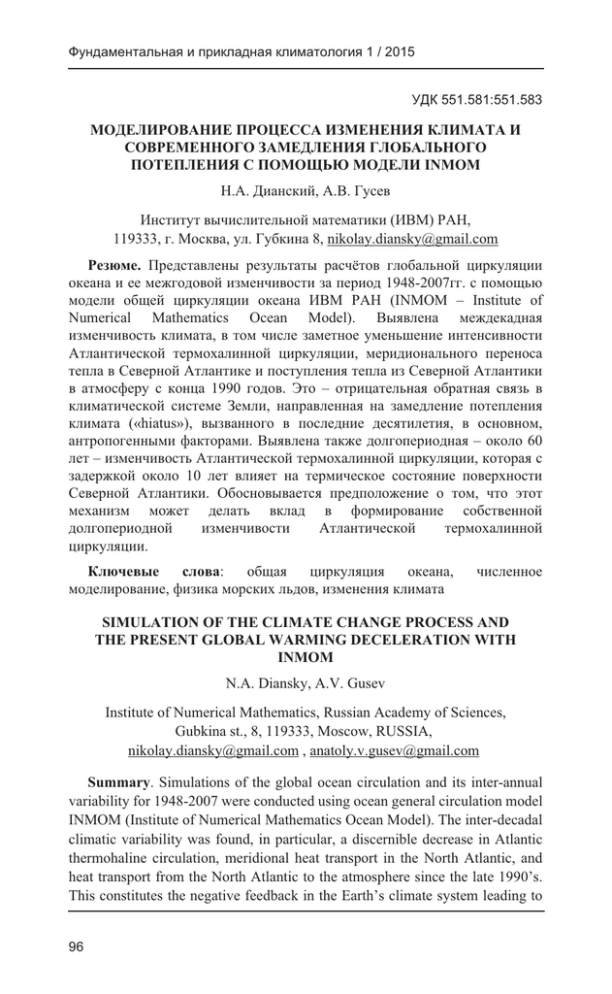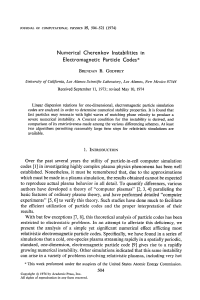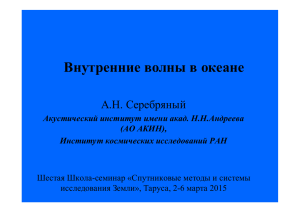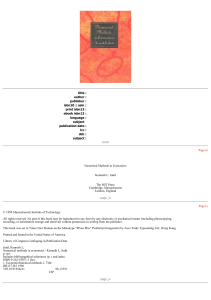МОДЕЛИРОВАНИЕ ПРОЦЕССА ИЗМЕНЕНИЯ КЛИМАТА И
advertisement

1 / 2015 E_' 551.581:551.583 ?J X >? ? ? >?J ?Q\ ?J INMOM ;.. D, .. > ! $$ (>X) ;, 119333, . X, . 8, nikolay.diansky@gmail.com . ! #! "" $ #$ # 1948-2007. $* $ * "" >X ; (INMOM – Institute of Numerical Mathematics Ocean Model). ! $ #$ $, $ #$ $( $% "", $ # $& " 1990 . ] – " # $ $ /$, #$ $ («hiatus»), !# , $, !$ &$. ! – 60 – #$ $% "", # 10 $ % . )! $, ' $%#$ $ &$ #$ $% "". : * "" , $, &# $% , #$ $ SIMULATION OF THE CLIMATE CHANGE PROCESS AND THE PRESENT GLOBAL WARMING DECELERATION WITH INMOM N.A. Diansky, A.V. Gusev Institute of Numerical Mathematics, Russian Academy of Sciences, Gubkina st., 8, 119333, Moscow, RUSSIA, nikolay.diansky@gmail.com , anatoly.v.gusev@gmail.com Summary. Simulations of the global ocean circulation and its inter-annual variability for 1948-2007 were conducted using ocean general circulation model INMOM (Institute of Numerical Mathematics Ocean Model). The inter-decadal climatic variability was found, in particular, a discernible decrease in Atlantic thermohaline circulation, meridional heat transport in the North Atlantic, and heat transport from the North Atlantic to the atmosphere since the late 1990’s. This constitutes the negative feedback in the Earth’s climate system leading to 96 1 / 2015 deceleration («hiatus») of climate warming caused primarily by anthropogenic factor in the last decades. Long-term variability of 60-year period in Atlantic thermohaline circulation was found. It influences the thermal state of the North Atlantic surface with 10 years delay. The hypothesis is justified that this mechanism can contribute to inherent long-term variability of Atlantic thermohaline circulation. Keywords: ocean general circulation, numerical simulation, sea ice physics, climate change ! # %*$ $!$ $$ #$$ $ # ", %*% – ($ # $ $! /$ ( ., 2010). ] #$ , # !% , % , !% % X (X)). '$ ($ $!$ $$ ( % # $ !! '$. ) # ! " $!% #$ $% "" X) "$ !% %. > #$ X) #$ !% $, !% ( %$!% &# $, ! 1960 ($. ! (, 1966; Bryan, 1969). % #( #! # $ * "" (X)[)). '$ #$! % ! $$ , !% $% ( $#"% !% ". ( ' !$ #$ ! %, # X)[) !% #( # 5° 1/10° (> ., 2012). ) !($ ' # ! #( # ! . '$ !% # # $ * $ $ $ !$ #($ ½°. ; # $ # % * "" $ $$ Coordinated Ocean-ice Reference Experiments (CORE) (Griffies et al., 2009; Danabasoglu et al., 2014). Z " "" X) #$ $$ %, $ $, * , ! # ! " '$ %! ! $& #. CORE-I (Griffies et al., 2009) * # $ #" 97 1 / 2015 $ , – CORE-II (Danabasoglu et al., 2014) – % $ #$, '$ # $ $$ #!% !% . ! #! '$ X)[) INMOM (Institute of Numerical Mathematics Ocean Model), !% $% CORE-II (Danabasoglu et al., 2014). * ! ! % " "", ! # # $ #$. 1 ,!! ! 0%( )!"&/$)!! & INMOM ! )"!$ !+ c&,"!' # >X ; X)[) INMOM $ (Griffies, 2005) $! X)[O ! !! $!, ! $! , !*% $( "" , $ % (, $! $$ #", # !% '$ (Griffies et al., 2009; Danabasoglu et al., 2014; Griffies, 2005, Marchuk et al., 2003; D, 2013; Zalesny et al., 2012). >% #, " # !% " $ &$" # !% . $! $ ! # ( ", *% % $%. ; $ INMOM (D, 2013). $ $!% % , # *!% !% % # -$ . $ $!$ $ #! $! , " $, #$* % (D, 2013; Zalesny et al., 2010). D # , !* $$ $ ! " # $ "" (Brydon et al., 1999). #" INMOM # $ * (X, 2009; Marchuk et al., 2005) &#$ "$ !$ $, % #!% $ (Griffies, 2005). D ' $ #! " $$# &$. ) # &&" # $$! !% , ! # !% "!$ $, $ #$ % '. ] #$ * # !% # % ! $" , ! '$ #$ 98 1 / 2015 %, !*$ % &&" #, *! ! #. #! $" !$ $ «C» – (J, 1964; Mesinger and Arakawa, 1976). X * # '&& #! ! $! ! %$! $, ! #$ # ( $ # (, $ $% , !% !% %$%, !$ !$ #($ '&&"$ # &&#. D $ # %$ +; $ $" , * " # $ * $ (X, 2009). ) # $" 2- 4- (D, 2013; Zalesny et al., 2012). D # 2- # %$ $ % $" !$ . D # 4- # %$ $ !$ $$ ( #$ . +$! # ! #$ " &$ (Zalesny et al., 2012), # $( ( #!% $"% -$ , ! & , * #! ! ! &, $ # ! & , #! . # & $! + $! . D $! $ # %$ X", – # $" , * % - "%. ] $% ! . &&# $! $ # &&# !$ '&&"$, # !$ $$ ( ., 2010). !% % # , $. D $! !% "% . ; "% , $ !% "% (D, 2013). 99 1 / 2015 >#$ INMOM X) $ , $ &$ # & $!. ) F$!, – $$ $ ', $ #$, ! $ $ &$. ) ' $ ' #%!% + , &$ %!% %!% , # , , ]-; – W . '$ % ' $ # ( # ' "!. D # % !% (% INMOM $ $ . ) # % $. X $$ (, 2009) ! $# , ! , % # !% ". X '" &, # $ %$ (Briegleb et al., 2004), * " "" $! . >, ", $ $ ! '" , #$ # # , %!% , * /$, % #$ $, ! -#- (Hunke and Dukowicz, 1997). D $ X # #( 1°×0,5° #!% % 40 $ !% - . ) ( $ % 1 , ( $! , ! %$, 30 $. F& , #$ $, ! # !% (ETOPO2, 2006). ] ! ! ! #$, $(! $( ( $ ! % & $! . +'&&" # &&# $! # !$ 4×106 $2/. '&&" # 4- # $ " 4- ( " ( $. , ' '&&" #$ ! 1,7×1021 $4/. D $( # $#" (Pacanovsky and Philander, 1981). #$ '&&" # #$ 1 $2/ 75 $2/, &&# – & # 0,05 $2/ 50 $2/. 100 1 / 2015 `! # #$!% " «!» !% & $! %$ , %$ 5-$$ '&&"! &&# # # !$ 500 $2/. &", '&&" &&# # 500 $2/, '&&" # !$ 75 $2/. D &&# # # % $" %$ $. ) INMOM $ $$ $ #$ $! ( , 2010, 2013), # >X ; * $$ X]>+ # #$ $, '$ $ # $" (F!% ., 2014). " CORE-II (Danabasoglu et al., 2014), $ ! !% 60-% ", *% 1948 2007 . D '$ $& # # " # CORE (Large and Yeager, 2009) %!% $&!% %, ! # NCEP/NCAR. !% # , X) $ $ , ! $ , # !% (Levitus et al., 1998), $*% #( 1/4° 33 !% &% #%. F % # $ $ "" 50-60 . $&! % CORE $ #%, ! 10 $ $& $ ($ 6 ); " ($ 24 ); $! $&! . #( '% $&!% % 1,8750°. ( #( $. C ' 1,9048°, $ 1,8888°. ! CORE ! #! ! & $ , $ $ $ ", ( J & #* # !% '$$ (, 2009). , $ % * -&$$ ($., $ (D, 2013)). ! , !% %, $!*% $ . 101 1 / 2015 $! % * " # $ #% # , " % . D # *. '$ * # % $$ !$ (Levitus et al., 1999) $ % $ " , * # $ $ % $ '&&" ! 1,5×10-4 $/, $ " $ , 10-$$ %$ , $$ #$, $!$ $($ 80 . ;%$ " % $ j $, # !. " CORE-II, *$ #!$ $ % $ – " ' (Danabasoglu et al., 2014), #! 5- 60- " $ ! !, %#* #$ "" X) # 1948 2007 . ; # #!% $% % % $ #$ # ' $. 2 ,"!! #"&'"!'!& '"#!( )!"&/$)!! ?!"+ & ! !# c)!! '"( ,! 20 & 2.1 ; . 1 # " 19482007. &" #- "" X (%) (#). L !% !#!$ $ % ' !$ '!$ $ (. 1, %). ] .. tropical shallow cells, !% F%$ !(, $ $. >$ '$ !! ! $ "" X , $ . ! % '% % $ !( 40 . [! '% ! 50 $ 5° ( '. W$ %( ! D (Bryan, 1991) 35 , $ 60°S 37°S * % 2 $. ) !$ '$$ &$, !#!$ !$ #!$ $ # .. «*% !%» "$ ([F). (Döös and Webb, 1994) ! ! 102 1 / 2015 &$ D !, ' , $ #% %. 1 – % " - "", %. 5 – , – # . $< , " – . 103 1 / 2015 + $ ($, ( #, , ! ! (Döös and Webb, 1994) ( # $ * $, # " & ' . ) $%% # (Levitus et al., 1998) X)[) ($. $, (D, 2013) . 2.8) # ", * , ! %! ! [F ! # & ! * #% % D . $ ( $(! $ &" $ $$$ 17 1 $ ( 35°.(. ] $ "" $ , $ $ (. 1, #). $ "" %( , $, #$ (Masumoto et al., 2004). ; . 2 #! $! (XF), ! $ # " 19482007 . XF # (% % "" X , #!*% ( $ $! /$ "$. #! %( , # $ ( 0,2 % (±30° (!), !$ # (Trenberth and Carron, 2001), ! XF ! $* !% " !$ . ] $ $ ( $ # CORE (Danabasoglu et al., 2014), ' " # * $ % !% "$ XF (Large and Yeager, 2009; Johns et al., 2011; Bryden and Imawaki, 2001). ! INMOM ! XF (. 2, ( ) $ $$$ 1,8 15°.(. $$$ – 1,2 14°.(. $ (, !( 40- , *, $, # $ , ! # #!$ !$ $ $ . (. 2, ! ) # 0,3 0,8 19°.(. ! $ $ $($ &$ – . ) XF 0,35 % ( ( #$! 0,3 '. ' 35°.(. !# $, ' , * # W$ , 104 1 / 2015 . ) $ $$! % 5 ( – 10 ), $ ! !# !$ '$$ $ W . + $ 1 $ ! "" $ %, * 15 , # . 2 – % , $5: * ( ), # ( ), + 8 ( ). W$ ( , !$ #$, "$ F%$ >$ %. $! '% % (. 2, ) $$$ 1,5 15°.(. 2.2 . ; . 3-6 #! ! $ $ $ (J)) *! $ , # 1948-2007., $! '" * $ j$ # ' . #! %( !$ # National Snow and Ice Data Center (NSIDC), !$ - ftp://sidads.colorado.edu/DATASETS/NOAA/G02135/. / $, # $!% !% $ 1987. . 3 !# $, 105 1 / 2015 ' )% $ ! %, ' * * J). 3 – 5 – & %[ " 1948-2007. \ ( ) NSIDC (), 106 2. 5 – , " 1948-2007. '$ * (. 4) ' , ' $ )% $ . +" * $ $ !$ $ 0,81, 0,87, %$ #$, ! #$!% % #( $. $, # # 106 1 / 2015 !% % $ , ! % #% #$ . D ' * $ 2006 2007. . 3 4. 4 – + <, 3, . ; . 7 ! ! *! $ #$ 2007., , !$ , J) ! $$!$ # . "$, $ $, $ "" &$ $ 107 1 / 2015 *. X$$ $* $. ! . 7 !$ NSIDC (ftp://sidads.colorado.edu/DATASETS/NOAA/G02135/), $ ! $, $ # %(. 5 – 5 – ~\ %[ " 1948-2007., 1012 3. 5 – & , " 1948-2007. 108 1 / 2015 6 – + <, 5, . 2.3 . ) # (% %, !*% $ #$ $ , $ "" (X)). > X) # $ $! % (F)) $ %, (70°W7°W, 0°-60°N). ) %# % 109 1 / 2015 (). $ % X) # #$ F) %!$ $!$ $($ 10 100 , ! ! #$ $ $ -$&. 7 – % %[ 2007. " \. 5 , – & . ; .8 ! & '" X). X! # ! X) $, $ $ F) 0°-60°N. (Gulev et al., 2013) #, $% #$ ' $ 110 1 / 2015 &# $. ) # $ $" # $ " %$ . D ' $ $ ! X). . 8 $ AMO !$ CORE, ( – #! INMOM. , $ %( # $ % X), j %($ #$ F), !$ !$ #$ $& #. #! ! $$$! $$$!, * % $, %( !$ (Large and Yeager, 2009). 8 – 8 # "" (#*[), °%, () \ ( ). #! '$ # "" X) # # &$ $ #$ 1948 2007. * # #$ $% "" (FL[). FL[ $(! $! ! , (J, 1984) &$ $! (XF) (. 2) ! (! (. ; . 9 # $ % FL[, XF # $& $ 111 1 / 2015 30°N 60°N. / FL[ ! $$$ &" # $ "" ( % (-). 9 – 5 " " # , % (), # , 30-60°.., $5 ( ") # , 30-60°.., 5/2. 112 1 / 2015 F$ #$, FL[ %# . $, FL[ 17 23,5 , $ 20,5 , %( "$ !$ #!$ $!$ $ (Danabasoglu et al, 2014). L # . 9, #! $( FL[ " 1990., $( % (%. > FL[ %# #!$ !$ $, *$ $$ F) (Latif et al., 2004). %%, #!% . 9, $ # 60- , !% % !% % $ #$ (, 2009). >&! ! ! "" X # " #$ !% %, #(( # 1948 2007 . X #! * $( * $ J) 2007., !$ . #$ ! #$ " 1990 . FL[, '" XF . F '% $ F) ' !, *$ X). F % FL[ X) j $, % $! % (% $( % J) % $. ]$ $% (Mokhov, 2006; D, 2006). # % , * !(!% !% " $ ( *$ #$$ $ &$ - *% FL[), (% %. ], , $ * # !% % $ !% % ( (, $ (IPCC, 2007). ), $ & ( #, !(, $ j # $ $% . F $! $$$! % FL[ XF, ! 1960. $ " $$$ X), 113 1 / 2015 #!$ 10-$ $ $, * $$$ X) % 1970. , $$$! % FL[ XF, ! 1990. $ " $$$ X), ! 2000. F $ ##! ( $ " X . ] $%#$ $ #$ FL[ $ 60 . ! FL[ " 1990 . $ $( XF % (% , , $( # $&, ! 1990. (. 9). ] , $ $"! $%#$ $ , !# , $, !$ #$ (IPCC, 2007). F$ #$, " # $ $ /$, $( ( #. >$ ', #$, 2000 . ! $( $ /$ (.. «hiatus») $ $ % $ ( . !$ $$ ' $%#$ $% "" X). F (Mokhov et al., 2006) #! # #$ FL[ $% $ Z# . % (Semenov et al., 2014) (Polonsky, 2013) $* $!% !% #$ $ #$% $. '% % ! #$ #$ &$ !%, !% #$ $, ($ #$. F, $ ! $%#$! ! $ #! ( $ #$, ! $$ (% !% , $ $$ $ $ $&! , # >X ;, $ $ $ , #$ *% %. ! $%#$! #$ FL[ X) $ &$ !% $% "" X), !, , $ &$ ! $. , $$ !% , *% $ $. 85* #L < ( G14-27-00126). 114 1 / 2015 !'"'/" Z.X., D ;.. X #$ $ XX-XXII % $* $ $ * "" $&! . >#. ;. # $&! , 2006, .42, 3, . 291-306. Z.X., D ;.., .. # $ $ $* $ $ * "" $&! INMCM 4.0. ># ;. # $&! , 2010, .46, 4, . 448-466. Z.X., D ;.., .. X #$ $! INMCM4: # # $% #$ 19-21 %. >#. ;. # $&! . 2013, .49, 4, .379-400. .. ` $ $ !% % # "" $ !% . D" &#-$$% , X, >X ;, 2009, 144 . D ;.. X "" " ! ! $&! #. –X., #$, 2013, 272 . > .., L .;., C( +.. %#(* 1/10° $ X // ># ;. # $&! , 48(1), 45-55, 2012. J .. + % " $ . > " #$ $&!., –X., $#, 1984, . 125-129. J .>. #! !% #, !% &&"!% !% !% # $$ &#. . !. $$. $$. &#., .4, 3, 1964, . 449-465. X .>. X! ! $$. // , J, 2009, 608 . .;. ) #$% $ !% #% /$ XX XXI %. D! $ ;, 2009, .427, 3, . 397-402. .. )! % . – J.: $#, 1966, 179 . $ .., X% >.>., .. X #$ 115 1 / 2015 &$ $ $ $ (. X &# , 2014, 4, . 1427. F!% X.., D ;.., .., + D.. # #!% $ $& "" $* $ $ $&! . ># ;. # $&! . 2014, .50, 2, . 131-142. ;.. $( $ J 1948-2002 . ` 1: ` $ . ># ;, ), 2009, .45, 3, . 1-16. Briegleb B.P., Bitz C.M., Hunke E.C., Lipscomb W.H., Holland M.M., Schramm J.L., and Moritz R.E. Scientific description of the sea ice component in the Community Climate System Model, version three. Technical Note NCAR/TN–463+STR, National Center for Atmospheric Research, Boulder, Colorado, 2004. Bryan K. A numerical method for the study of the circulation of the world ocean // J. Computational Physics, 1969, V.4, pp. 347-376. Bryan K. Ocean circulation models / Strategies for Future Climate Research. M. Latif, Ed. Max-Plank Institute für Meteorologie, 1991, pp. 265-286. Bryden, H., Imawaki, S., 2001. Ocean heat transport. In: Siedler, G., Church, J., Gould, J. (Eds.), Ocean Circulation and Climate. In: International Geophysical Series, vol. 47. Academic Press, pp. 317– 336. Brydon D., San S., Bleck R. A new approximation of the equation of state for seawater, suitable for numerical ocean models // J.Geoph.Res, 1999, V.104, C1, pp. 1537-1540. Danabasoglu, G., S.G. Yeager, D. Bailey, E. Behrens, M. Bentsen, D. Bi, A. Biastoch, C. Boning, A. Bozec, V. Canuto, C. Cassou, E. Chassignet, A.C. Coward, S. Danilov, N. Diansky, H. Drange, R. Farneti, E. Fernandez, P.G. Fogli, G. Forget, Y. Fujii, S.M. Griffies, A. Gusev, P. Heimbach, A. Howard, T. Jung, M. Kelley, W.G. Large, A. Leboissetier, J. Lu, G. Madec, S.J. Marsland, S. Masina, A. Navarra, A.J.G. Nurser, A. Pirani, D. Salas y Melia, B.L. Samuels, M. Scheinert, D. Sidorenko, A.-M. Treguier, H. Tsujino, P. Uotila, S. Valcke, A. Voldoire, and Q. Wang, 2014: North Atlantic simulations in Coordinated Ocean-ice Reference Experiments phase II (CORE-II). Part I: Mean states. Ocean Modelling, 73, pp. 76-107. Döös K., Webb D.J. The Deacon Cell and the Other Meridional Cells of the Southern Ocean // J. Phys. Oceanogr, 1994, V.24, pp. 429-442. 116 1 / 2015 Griffies, S.M. 2005: Some ocean model fundamentals. In: Ocean Weather Forecasting: an integrated view of Oceanography. E.P. Chassignet & J. Verron, eds., Berlin, Germany: Springer, pp. 19-74. Griffies S.M., A. Biastoch, C. Boning, F. Bryan, E. Chassignet, M. England, R. Gerdes, H. Haak, R.W. Hallberg, W. Hazeleger, J. Jungclaus, W.G. Large, G. Madec, B.L. Samuels, M. Scheinert, A. Sen Gupta, C.A. Severijns, H.L. Simmons, A.-M. Treguier, M. Winton, S. Yeager, J. Yin., 2009. Coordinated Ocean-ice Reference Experiments (COREs), Ocean Modelling, 26, pp. 1-46. Gulev S.K., M. Latif, N. Keenlyside, W. Park and K. P. Koltermann. North Atlantic Ocean control on surface heat flux on multidecadal timescales. Nature 499, pp. 464-467 (24 July 2013) doi:10.1038/ nature12268. Hunke E.C and J.K. Dukowicz. An elastic-viscous-plastic model for sea ice dynamics // J. Phys. Oceanogr, 1997, V.27, pp. 1849-1867. Johns W.E., Baringer M.O., Beal L.M., Cunningham S.A., Kanzow T., Bryden H.L., Hitschi J.J.M., Marotzke J., Meinen C.S., Shaw B., Curry R., 2011. Continuous, array-based estimates of Atlantic Ocean heat transport at 26,5°N. J. Clim. 24, pp. 2429-2449. IPCC, 2007: Climate Change 2007: The Physical Science Basis. Contribution of Working Group I to the Fourth Assessment Report of the Intergovernmental Panel on Climate Change [Solomon S., D. Qin, M. Manning, Z. Chen, M. Marquis, K.B. Averyt, M. Tignor and H.L. Miller (eds.)]. Cambridge University Press, Cambridge, United Kingdom and New York, NY, USA, 996 pp. Large W., Yeager S., 2009. The global climatology of an interannually varying air–sea flux data set. Clim Dyn, V.33, pp. 341-364. Latif M., Roeckner E., Botzet M., et al., 2004: Reconstructing, monitoring, and predicting decadal-scale changes in the North Atlantic thermohaline circulation with sea surface temperature. J. Climate, 17, pp. 1605-1614. Levitus S., Boyer T., Conckright M., Johnson D., O’Brrien T., Antonov J., Stephens C., Gelfeld R. World Ocean Database 1998. Atlas NESDIS 18, NOAA. Marchuk G.I., Schroeter J., Zalesny V.B. Numerical study of the global ocean equilibrium circulation. Russ. J. Num. Anal. Math. Modelling, 2003, V.18, 4, pp. 307-335. Marchuk G.I., Rusakov A.S., Zalesny V.B., Diansky N.A. Splitting Numerical Technique with Application to the High Resolution Simulation of the Indian Ocean Circulation // Pure appl. Geophys, 2005, V.162, pp. 1407-1429. 117 1 / 2015 Y. Masumoto, H. Sasaki, T. Kagimoto, N. Komori, A. Ishida, Y. Sasai, T. Miyama, T. Motoi, H. Mitsudera, K. Takahashi, H. Sakuma and T. Yamagata. A Fifty-Year Eddy-Resolving Simulation of the World Ocean. Preliminary Outcomes of OFES (OGCM for the Earth Simulator) // Journal of the Earth Simulator, V. 1, April 2004, pp. 35-56. Mesinger F. and A. Arakawa, 1976: Numerical methods used in atmospheric models. WMO/ISCU Joint Organising Committee, GARP Publications Series 17, V. I, 64 pp. Mokhov I.I. (2006), Model estimates of possible climate changes in the 21st century in comparison to climate changes in the past and present, in: Possibilities of Preventing Climate Change and its Negative Consequences: The Problem of Kyoto Protocol, Material of Council-Seminar with President of RAS, p. 75, Nauka, Moscow. Pacanovsky R.C., Philander G. Parametrization of vertical mixing in numerical models of the tropical ocean // J. Phys. Oceanogr, 1981, V. 11, pp. 1442-1451.Polonsky A.B. Large-scale ocean-atmosphere interaction and its impact on global and regional climate variability. National Academy of Sciences of Ukraine, Marine Hydrophysical Institute. – K.: Akademperiodyka, 2013, 126 p. Trenberth, K.E. and J.M. Carron, 2001. Estimates of meridional atmosphere and ocean heat transports. J. Climate, V.14, pp. 34333444. Zalesny V.B., Marchuk G.I., Agoshkov V.I., Bagno A.V., Gusev A.V., Diansky N.A., Moshonkin S.N., Tamsalu R., Volodin E.M. Numerical simulation of large-scale ocean circulation based on the multicomponent splitting method // Russ. J. Numer. Anal. Math. Modelling, 2010, V.25, 6, pp. 581-609. Zalesny V.B., Diansky N.A., Fomin V.V., Moshonkin S.N., Demyshev S.G. Numerical model of the circulation of the Black Sea and the Sea of Azov. Russ. J. Numer. Anal. Math. Modelling, 2012, V.27, 1, pp. 95-111. «2-minute Gridded Global Relief Data (ETOPO2v2)», U.S. Department of Commerce, National Oceanic and Atmospheric Administration, National Geophysical Data Center, 2006. 118



